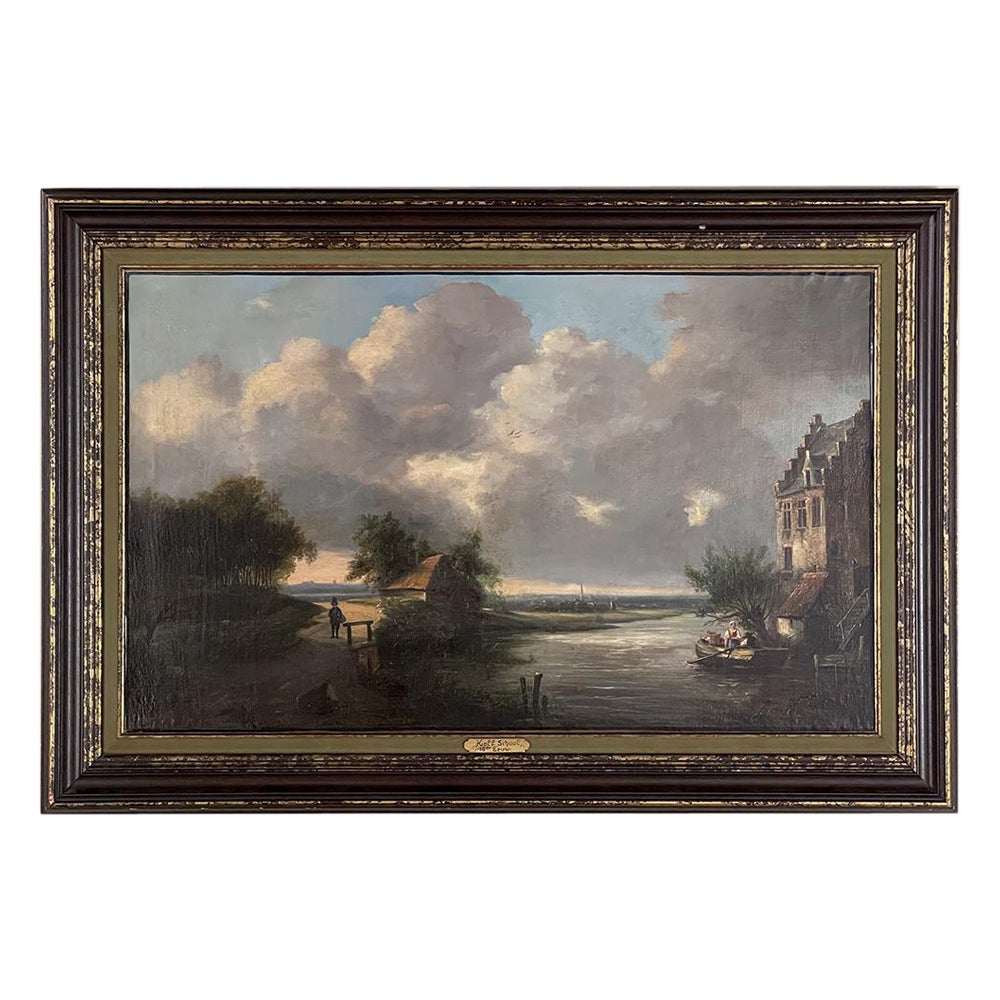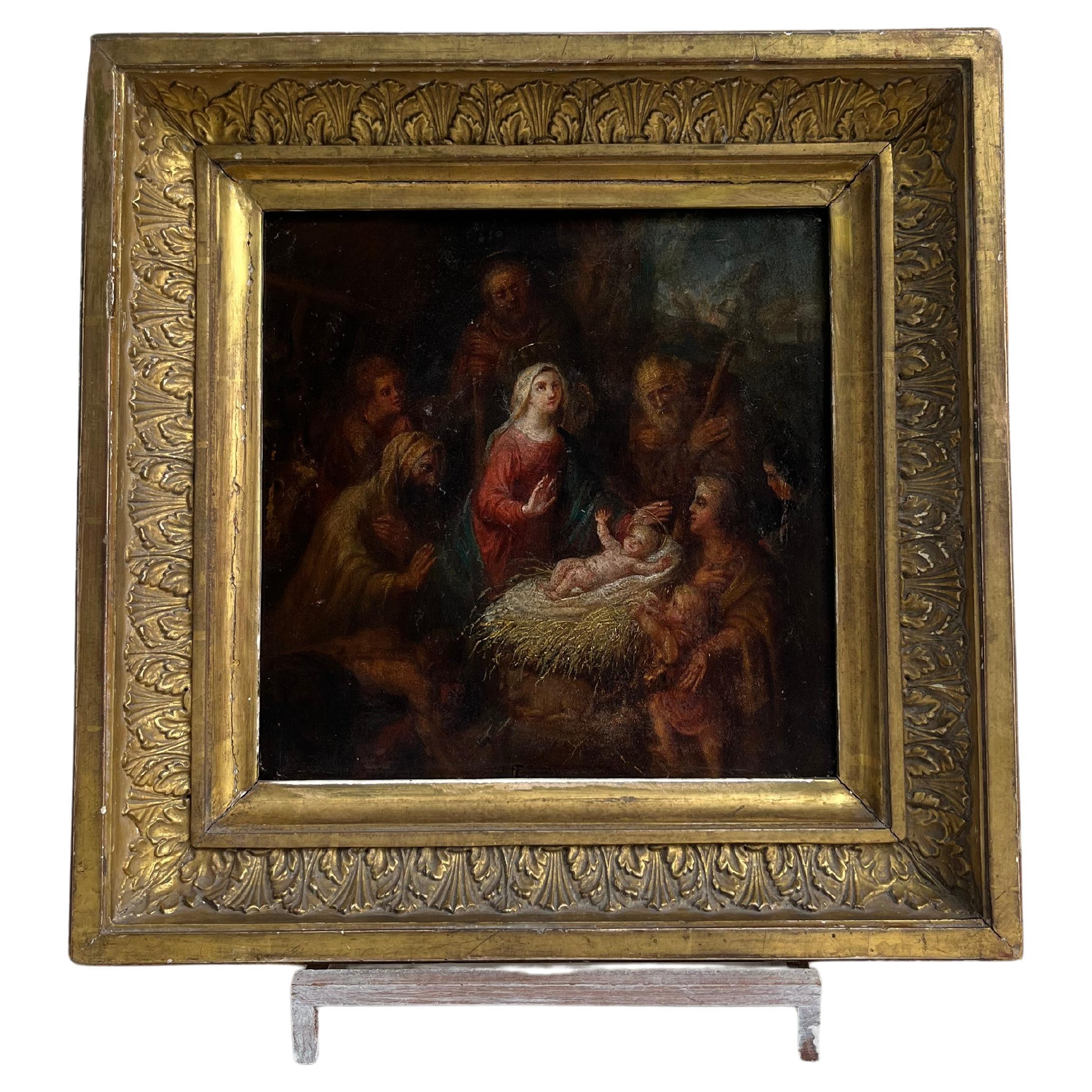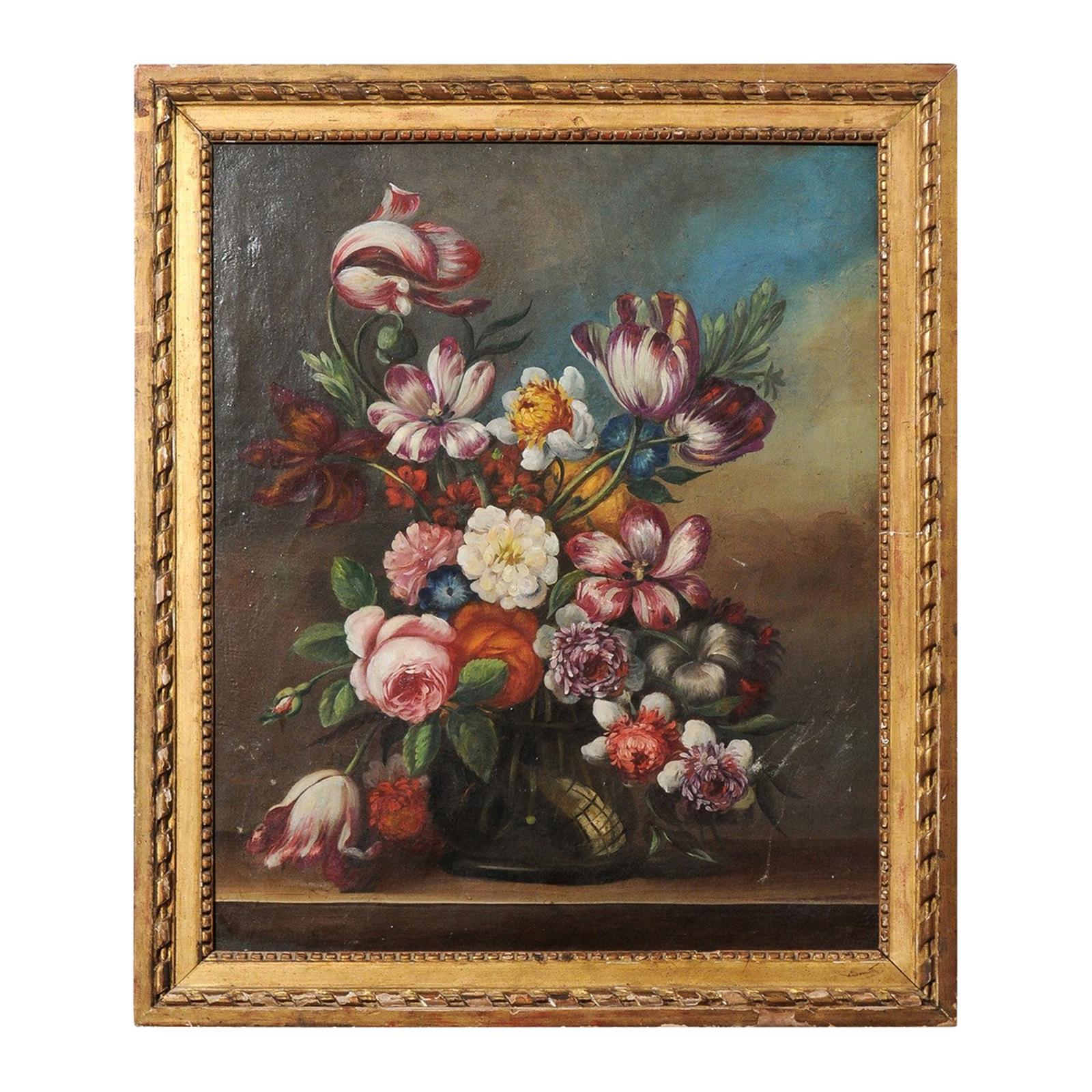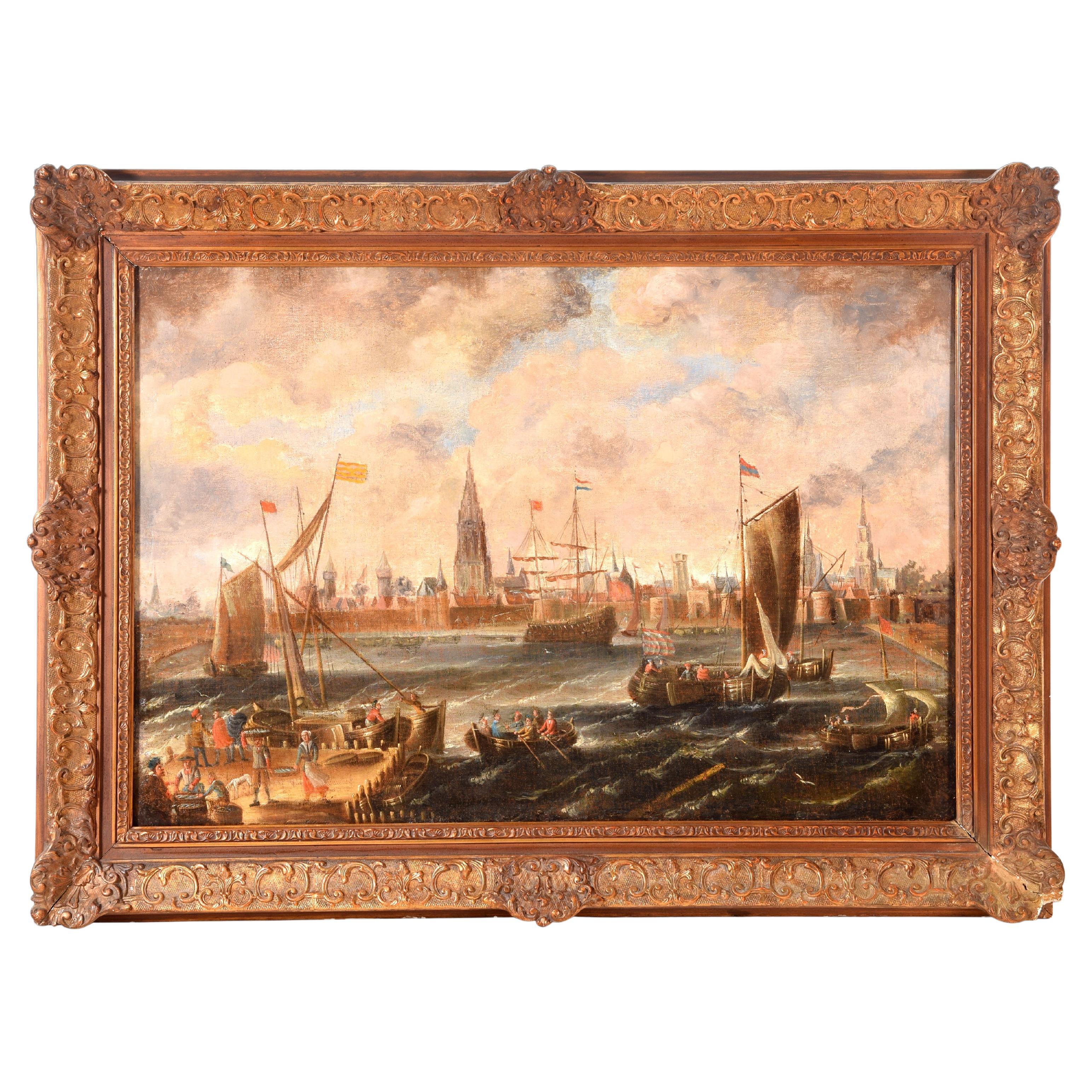Items Similar to 18th Century The Sacrifice of Iphigenia Roma School Painting Oil on Canvas
Want more images or videos?
Request additional images or videos from the seller
1 of 14
18th Century The Sacrifice of Iphigenia Roma School Painting Oil on Canvas
About the Item
Roman school, 18th century
The Sacrifice of Iphigenia
Oil on canvas, Measures: 50 x 64.5 cm
The canvas depicts The Sacrifice of Iphigenia, a theme reported by numerous sources, including the Greek tragedies Iphigenia in Aulis by Euripides and Agamemnon by Aeschylus, as well as in Ovid's Metamorphoses. The myth tells how the Greeks, under the command of Agamemnon, gathered at the city of Aulis, in Boeotia, from which they then set sail for Troy. The persistent calm of the winds, however, prevents the Greek ships from taking to the sea and the forced stay of the armies in the city favors the spread of an epidemic. Discontent runs rampant and Agamemnon's authority falters. The king then questions the soothsayer Calcante to get some insight into what to do. The latter reveals to him that the difficult situation is the result of Artemis' anger towards Agamemnon himself, guilty of killing, during a hunt, a doe dear to the goddess. The only way to overcome the impasse - continues Calcante - is to sacrifice to Artemis Iphigenia, daughter of Agamemnon. The chief of the Greeks accepts and makes sure that the girl, accompanied by her mother Clytemnestra, reaches Boeotia: to induce mother and daughter to travel Agamemnon, lying, lets them know that Achilles has asked Iphigenia in marriage. Upon the arrival of Iphigenia in Boeotia, Agamemnon's deception is soon revealed, but the girl nevertheless agrees to sacrifice herself to allow the Greek army to reach Troy. he lets them know that Achilles has asked for Iphigenia in marriage. Upon the arrival of Iphigenia in Boeotia, Agamemnon's deception is soon revealed, but the girl nevertheless agrees to sacrifice herself to allow the Greek army to reach Troy. he lets them know that Achilles has asked for Iphigenia in marriage. Upon the arrival of Iphigenia in Boeotia, Agamemnon's deception is soon revealed, but the girl nevertheless agrees to sacrifice herself to allow the Greek army to reach Troy.
Our canvas, the work of a Roman Neoclassical painter, is taken from an engraving and a painting by the seventeenth-century painter Pietro Testa (Lucca, 1612 - Rome, 1650). As can be seen in the inscription contained in the first edition of the engraving (later eliminated), the print with the sacrifice of Iphigenia was dedicated by Pietro Testa to Mario Albrizzi, ecclesiastical holder of the office of referendum of the Two Signatures, judicial body of the pontifical administration. The complex dedication to the high prelate contains an eulogy to the purity of the design which is sometimes corrupted by the inadequate use of color. Mentioned by Passeri as one of the highest proofs of the Testa in the field, the engraving (as you can read on the step of the base of the altar) was printed in the printing house set up by Giovanni Giacomo de Rossi in Rome, in via della Pace. The print is signed with the monogram used by the artist (which superimposes a P, a T and an L, Petrus Testa Lucensis, ie Lucca) followed by the words pinx. [It] and sculp. [Sit]. The canvas that Testa derived from it is now kept at the Galleria Spada in Rome.
- Dimensions:Height: 19.69 in (50 cm)Width: 25.4 in (64.5 cm)Depth: 1.58 in (4 cm)
- Materials and Techniques:
- Place of Origin:
- Period:
- Date of Manufacture:18th Century
- Condition:Refinished. Wear consistent with age and use. The painting has been cleaned.
- Seller Location:Milan, IT
- Reference Number:1stDibs: LU5918226733962

About the Seller
5.0
Vetted Seller
These experienced sellers undergo a comprehensive evaluation by our team of in-house experts.
Established in 2000
1stDibs seller since 2021
26 sales on 1stDibs
Typical response time: 13 hours
- ShippingRetrieving quote...Ships From: Milan, Italy
- Return PolicyA return for this item may be initiated within 14 days of delivery.
More From This SellerView All
- 18th Century Scene with Spinner Piedmontese school Painting Oil on CanvasLocated in Milan, IT18th century, Piedmontese, School Scene with spinner Measures: Oil on canvas, 50 x 60 cm Frame 70 x 80 cm.Category
Antique 18th Century Italian Paintings
MaterialsCanvas
- 17th-18th Century View of the Temple of Minerva Painting Oil on CanvasLocated in Milan, ITPainter active in Rome in the 18th-19th century. View of the temple of Minerva Medica Oil on canvas, 65 x 78 cm - with frame 71.5 x 85 cm The painting bears a traditional attribution to François Marius Granet (Aix-en-Provence, 1775 - 1849). The painter was a pupil of David but from 1802 to 1819 he lived in Rome, as evidenced by a series of paintings depicting views of the city and especially of the Roman countryside (Ponte San Rocco in Tivoli, 1810-20, MoMA, New York), and then return there between 1825 and 1830. In the Eternal City Granet devoted himself to landscape painting, inspired by the landscape painting of Gaspard Dughet and Van Lint...Category
Antique Late 17th Century Italian Paintings
MaterialsCanvas
- 18th Century St. Francis Receives the Stigmata Painting Oil on CanvasLocated in Milan, ITXVIII century St. Francis receives the stigmata Oil on canvas, 97 x 75.5 cm.Category
Antique 18th Century Italian Paintings
MaterialsCanvas
- 18th Century Portrait of Felice Paganoni Painting Oil on CanvasLocated in Milan, ITAttributed to Giacomo Ceruti (Milan, 1698-1767) Portrait of Felice Paganoni Oil on canvas, 98.5 x 73 cm With frame, 109 x 85 x 4 cm "Felice Pag...Category
Antique 18th Century Italian Paintings
MaterialsCanvas
- 18th Century Cherub Head Sketch Painting Oil on CanvasLocated in Milan, ITVenetian school, 18th century Study with the head of a cherub Measures: Oil on canvas, 45.5 x 41 cm - with frame 54.5 x 49.5 cm The present qualifies as a study or preparatory sketch by virtue of the structural and figural layout; by reason of formal and substantial evidence, it can be traced back to the mature neo-Venetian style, which in the eighteenth century had begun to produce figurations of extreme typological pathetism and formal expressionism. The contemporary painting experience of Tiepolo commanded the Venetian art scene, once the lesson of Pier Francesco Mola (1612-1666) was overruled. The delicate putto head offered here, in which a cherub is recognizable due to the happy iconographic solution of the wings placed under the angel's face, is outlined with a vigorous vitalism. A foreshortened point of view illuminates his face in a grazing way, probing his features with strong shadows and with a youthful blush that orange his cheeks. The veristic perfection with which the artist arranges the semblant is of marvelous expressiveness. The eyes are swollen with intensity, and together with the general setting of the head they denounce a conscious reflection on the physiognomy, peculiar within the emerging context of Venetian painting. The painting in question is affected by the large-scale productions, both monumental and perspective, at the time in vogue in the territory of the Serenissima. Conceived through a vision from below, the portrait reveals from the Venetian Rococo that particular predilection for the open and clear, airy ways, denounced in the first instance by Tiepolo. The conscious detachment from the Cortona-style decorativism and from the repeated layout solutions then in vogue allow us to approach the present to the production of Francesco Fontebasso...Category
Antique 18th Century Italian Rococo Paintings
MaterialsCanvas
- Oil painting on canvas depicting Still life Roman school of the 17th centuryLocated in Milan, ITRoman School, 17th century Still Life Oil on canvas, 79 x 107 cm Framed, 93 x 121 cm The work under scrutiny, depicting a majestic still life of flowers, is ascribed to the 17th...Category
Antique 17th Century Paintings
MaterialsCanvas
You May Also Like
- 18th Century Oil on Canvas Italian SchoolBy Carlo MarattaLocated in Marseille, FRPainting with probably biblical Italian school characters End of the 17th beginning of the 18th century unsigned carrying a Carlo Maratta cartouche of in...Category
Antique Early 18th Century Italian Baroque Paintings
MaterialsCanvas
- 18th Century Framed Oil Painting on Canvas by Holland SchoolLocated in Dallas, TX18th century framed oil painting on canvas by Holland School is a panoramic landscape with prominent contrasting features, rendered in the Dutch style. The foreground is divided into...Category
Antique Late 18th Century Dutch Aesthetic Movement Paintings
MaterialsCanvas
- European School Oil on Panel of the 18th CenturyBy EuropaLocated in Madrid, ESEuropean School oil on panel of the 18th century Measures: 34X24CM Good condition.Category
Antique 18th Century German Baroque Paintings
MaterialsPaint
- Adoration of the Shepherds, French School, Oil on Canvas, 18th Century, FramedLocated in Lisboa, PTAdoration of the Shepherds, French School. Oil on canvas, 18th Century. Framed.Category
Antique 18th Century French Paintings
MaterialsPaint
- French 18th Century Oil on Canvas Floral Painting in the Dutch School StyleLocated in Atlanta, GAA French oil on canvas still-life floral painting in the Dutch School style from the 18th century, in giltwood frame. Born in France during the Age of Enlightenment, this exquisite floral painting presents a strong influence from the Dutch School. Capturing our attention with its bright colors and skillfully depicted presence, a luscious bouquet of flowers displayed on a tabletop, stands out beautifully on a neutral blue and golden background. Pink, white, orange, green, blue and red tones among others are playing with one another in a subtle dance that leaves us mesmerized. Set inside a giltwood frame accented with twisted ribbons and petite beads, this 18th century French floral oil...Category
Antique 18th Century French Paintings
MaterialsCanvas, Giltwood, Paint
- View of the pier of Antwerp. Oil on canvas. Flemish school, 18th century.Located in Madrid, ESView of the pier of Antwerp. Oil on canvas. Flemish school, 18th century. Numerous ships and boats appear in the landscape, accompanied by small characters. In the background a city...Category
Antique 18th Century European Neoclassical Paintings
MaterialsOther
Recently Viewed
View AllMore Ways To Browse
Canvas Holder
18th Century Italian School Painting
18th Century Girl
Antique Oil Painting Hunt
Antique Goddess Painting
Hand Painting Goddess
Wall Altar
Roman Inscription
Altar Set
Hunt Engraving
Artemis Antique
Roman Altar
Altar House
Artemis Painting
Ovid Metamorphoses
Artemis Italy
Albrizzi Designs
Antique Print Holder





